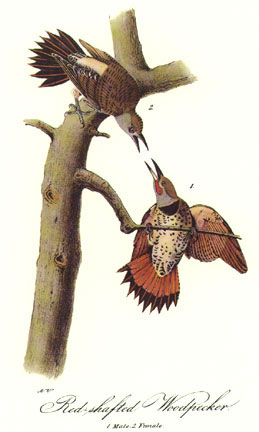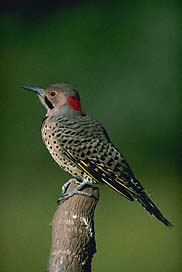| Red-shafted Northern Flicker
A couple of mornings ago I was having my morning cup of coffee and looking out my back windows at Honeymoon Lake. I find it somehow soothing just looking at the water. It's always different depending on the quality of the light, the strength of the wind, and the time of year.
I saw a bird on my lawn that I had never seen before. It was very dilligently pecking at the ground with a long, thin, black beak. Just pecking away. I quickly grabbed my binoculars, grabbed a quick look and started flipping through pages of the bird book. It didn't take long to find.

Northern Flicker Colaptes auratus
This beautiful species was first described by Mr. SWAINSON from Mexican specimens. The extent of its distribution is as yet imperfectly known, especially toward the north. My friend Mr. NUTTALL states, that "among the narrow belt of forest which borders Lorimie's Fork of the Platte, we met with the Mexican Colaptes, and never scarcely lost sight of it to the shores of the Pacific. Its manners in all respects are so entirely similar to those of the common species, that the same description applies to both. It is, however, always a much shyer bird, and frequents the ground less. In the breeding season it utters the same echoing note of whittoe, whittoe, whittoe; the males at the same time dodging after, and pursuing each other in jealousy and anger. They also burrow into the oak or pine trees, and lay white eggs, after the manner of the whole family. How far they proceed to the north I am unable to say." Mr. TOWNSEND informs me that it is known to the Chinook Indians by the name of A-Koptil-Kow, and in regard to habits is similar to Picus auratus, the male equally partaking of the task of incubation.
[read more]
Picture and text by John James Audubon.
This is a bird that has different races. I didn't know birds did that. There are two populations, red-shafted on the west coast and yellow-shafted on the east coast, separated by the Great Plains. Audubon had an earlier bird he classified as the Golden-winged Woodpecker. They are both considered to be a Northern Flicker Colaptes auratus. The red and yellow refers to the colors under the wings and tail.
The Northern Flicker is also the state bird of Alabama. You wouldn't think a good Confederate state like Alabama would pick a "northern" bird, would you? Well, they didn't. It's old name is Yellowhammer (for the yellow-shafted race on the east coast.)
It is classified as a woodpecker but it does most of its pecking in the ground and some pecking on rotten logs. It loves ants and beetle babies.
Northern Flicker Colaptes auratus
Northern Flicker Colaptes auratus
Northern Flicker Colaptes auratus
Northern Flicker

This is actually a Yellow-shafted Northern Flicker. The one I saw was pretty much like this except the black cheek mark was red.
Check out someof the other birds at Honeymoon Lake. |

